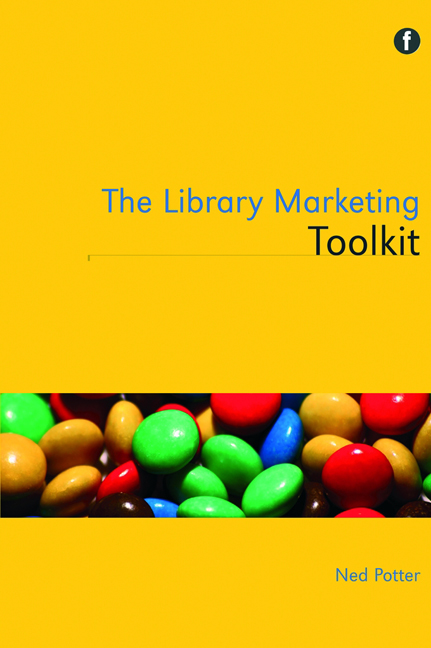Book contents
- Frontmatter
- Dedication
- Contents
- Acknowledgements
- Introduction
- 1 Seven key concepts for marketing libraries
- 2 Strategic marketing
- 3 The library brand
- 4 Marketing and the library building
- 5 An introduction to online marketing
- 6 Marketing with social media
- 7 Marketing with new technologies
- 8 Marketing and people
- 9 Internal marketing
- 10 Library advocacy as marketing
- 11 Marketing special collections and archives
- A final word on marketing libraries
- Appendix: Glossary of Web 2.0 tools and platforms
- References
- Index
10 - Library advocacy as marketing
Published online by Cambridge University Press: 08 June 2018
- Frontmatter
- Dedication
- Contents
- Acknowledgements
- Introduction
- 1 Seven key concepts for marketing libraries
- 2 Strategic marketing
- 3 The library brand
- 4 Marketing and the library building
- 5 An introduction to online marketing
- 6 Marketing with social media
- 7 Marketing with new technologies
- 8 Marketing and people
- 9 Internal marketing
- 10 Library advocacy as marketing
- 11 Marketing special collections and archives
- A final word on marketing libraries
- Appendix: Glossary of Web 2.0 tools and platforms
- References
- Index
Summary
At first glance internal marketing and library advocacy are opposites, with one being very inwardfacing and the other very outwardfacing – but in fact the two are closely linked. They both involve proving the library's value to people who really matter. I firmly believe that we are alllibrary advocates now. It is not something any information professional can afford to abstain from; in fact to abstain is to contribute to the problem.
Marketing and advocacy have a close link. They are both about the promotion of libraries and library services. The point of this brief chapter is to explore how library advocacy per se can be used as a marketing opportunity for your specific library. It will also introduce ‘the echo chamber problem’ – an issue which afflicts all libraries but one which can be addressed relatively easily with a slight shift in mindset – and features a case study from Elizabeth Elford, Head of Advocacy at the British Library.
National campaigns and local marketing
In a time of closures and cuts, national library advocacy campaigns are increasingly frequent. They are of course an entirely worthwhile thing to be part of in their own right, but it's also possible to glean direct, regional benefit for your library even from a national campaign about libraries in general.
Jan Richards coordinated the ‘@ your librar’ campaign in New South Wales, Australia. He provides a full case study all about this online (see the further reading for this chapter on the website) but here are some pertinent quotes about the local value libraries derived from it:
The @ your librarycampaign was designed to be delivered at a local level but to
gain strength from the same story being told from many different
viewpoints/places. So while libraries used their traditional channels to promote
the initiative it was often picked up at a regional level because of the ‘nois’ of the
message. There was also the opportunity to use this strength in selling the story
to the major news agencies.
- Type
- Chapter
- Information
- The Library Marketing Toolkit , pp. 169 - 176Publisher: FacetPrint publication year: 2012



